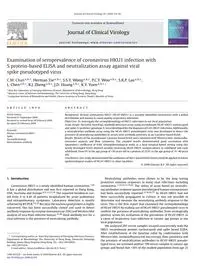
2009 Examination of seroprevalence of coronavirus HKU1 infection with S protein-based ELISA and neutralization assay aga PDF
Preview 2009 Examination of seroprevalence of coronavirus HKU1 infection with S protein-based ELISA and neutralization assay aga
Journal of Clinical Virology 45 (2009) 54–60 Contents lists available at ScienceDirect Journal of Clinical Virology journal homepage: www.elsevier.com/locate/jcv Examination of seroprevalence of coronavirus HKU1 infection with S protein-based ELISA and neutralization assay against viral spike pseudotyped virus C.M. Chan a,b,c, Herman Tse a,b,c, S.S.Y. Wong a,b,c, P.C.Y. Woo a,b,c, S.K.P. Lau a,b,c, L. Chen a,b,c, B.J. Zheng a,b,c, J.D. Huang a,b,c, K.Y. Yuen a,b,c,∗ a State Key Laboratory of Emerging Infectious Diseases, Department of Microbiology, Hong Kong b Research Center of Infection and Immunology, The University of Hong Kong, Hong Kong c Guangzhou Institute of Biomedicine and Health, Chinese Academy of Sciences, People’s Republic of China a r t i c l e i n f o Article history: Received 27 September 2008 Received in revised form 24 February 2009 Accepted 25 February 2009 Keywords: Human coronavirus HKU1 Spike Seroepidemiology Neutralization antibody a b s t r a c t Background: Human coronavirus HKU1 (HCoV-HKU1) is a recently identified coronavirus with a global distribution and known to cause mainly respiratory infections. Objectives: To investigate the seroepidemiology of HKU1 infections in our local population. Study design: An ELISA-based IgG antibody detection assay using recombinant HCoV-HKU1 nucleocapsid and spike (S) proteins (genotype A) were developed for the diagnosis of CoV-HKU1 infections, Additionally, a neutralization antibody assay using the HCoV-HKU1 pseudotyped virus was developed to detect the presence of neutralizing antibodies in serum with antibody positivity in an S protein-based ELISA. Results: Results of the recombinant S protein-based ELISA were validated with Western blot, immunoflu- orescence analysis and flow cytometry. The coupled results demonstrated good correlation with Spearmen’s coefficient of 0.94. Seroepidemiological study in a local hospital-based setting using this newly developed ELISA showed steadily increasing HCoV-HKU1 seroprevalence in childhood and early adulthood, from 0% in the age group of <10 years old to a plateau of 21.6% in the age group of 31–40 years old. Conclusions: Our study demonstrated the usefulness of the S-based ELISA which could be applied to future epidemiological studies of HCoV-HKU1 in other localities. © 2009 Elsevier B.V. All rights reserved. 1. Introduction Coronavirus HKU1 is a newly identified human coronavirus.7,20 It has a global distribution and was first reported in Hong Kong, USA, Australia and Europe.4,13,21,23,38 The reported incidences var- ied from 0 to 4.4% of patients hospitalized for acute pulmonary and extrapulmonary symptoms. Laboratory detection is mostly achieved by RT-PCR.5,6,29 Because the nucleocapsid protein is highly conserved, this has been successfully cloned and used to detect antibody response by enzyme immunoassay (EIA) and Western blot analysis of sera from infected human.35,40 Ideal antibody test for a viral infection is the presence of neutralizing antibody. ∗ Corresponding author at: State Key Laboratory of Emerging Infectious Diseases, Department of Microbiology, The University of Hong Kong, University Pathology Building, Queen Mary Hospital, Hong Kong. Tel.: +852 28554892; fax: +852 28551241. E-mail address:
